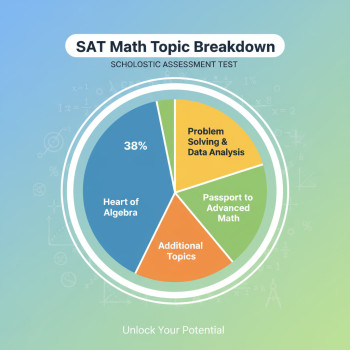Why Tracking Progress Matters (and Why It’s Not Just About Scores)
Preparing for the Digital SAT can feel like climbing a hill that’s steeper than you remember. One week, you’re crushing practice sections; the next, a single timed reading passage knocks your confidence. That’s normal. What separates anxious, spinning students from calm, steadily improving ones is not raw talent — it’s tracking. Tracking your progress turns fuzzy hope into a clear map: it tells you where you’ve been, what’s working, and where to focus next.
Good progress tracking does three things: it makes study decisions objective, it motivates by showing small wins, and it helps you allocate time to the right weak spots instead of guessing. Think of it as GPS for your SAT prep — you wouldn’t drive across the country without directions, so why study without measurable feedback?
What to Track: Key Metrics That Actually Predict Improvement
Not every statistic is useful. Some metrics are vanity metrics (e.g., “hours studied” alone), while others reveal real learning. Focus on a few meaningful data points that give you actionable insight.
1. Practice Test Scores (and Their Subscores)
Full-length practice tests are your north star. Track your overall Digital SAT score, and — importantly — the section/subscore breakdowns (e.g., Reading, Writing & Language, Math with/without calculator if your prep materials separate them). These give a snapshot of where you are on test day stamina and strategy.
2. Question Accuracy by Content Type
Instead of looking only at percent correct, tag questions by content (e.g., algebra, geometry, data analysis, evidence-based reading, grammar conventions). Over several weeks, a pattern will appear: maybe you nail algebra but stumble on vocabulary-in-context or on geometry diagrams.
3. Timing and Pacing Metrics
Digital SAT changes the way you pace — so track how long you spend per question on average, number of questions left unanswered, and sections where you consistently rush. Timing issues often masquerade as content weaknesses.
4. Error Types
Record why you missed a question: careless mistake, misunderstanding, lack of content knowledge, or poor strategy. Over time, you’ll see whether you’re losing points to avoidable errors or to gaps in understanding.
5. Consistency and Streaks
Track how often you meet small goals (e.g., hit a target score on practice sections, complete a timed practice set) because improvement is a series of consistent small wins. A streak calendar is a powerful motivator.
Tools and Simple Systems for Tracking Progress
You don’t need fancy software to be effective — a notebook can work. But combining simple tools with good habits speeds up insight. Here are practical systems you can use.
Spreadsheet Tracker
Create a spreadsheet with columns for date, test name, overall score, section scores, accuracy by content area, timing notes, and action items. Spreadsheets are flexible: you can graph trends, calculate averages, and filter by topic.
Weekly Review Session
Set aside 30–60 minutes each week to review the data you collected. Ask three questions: What improved? What didn’t? What will I change in the upcoming week? This ritual is the single highest-leverage activity for sustained growth.
Question Log (Error Notebook)
Whenever you miss a question on practice problems or a test, record it in a question log. Include the question topic, your answer, the correct answer, and a short note explaining the error. Review this log periodically — it’s the quickest way to eliminate recurring mistakes.
Digital Tools and Features to Consider
- Built-in analytics from practice platforms: show score trends and breakdowns.
- Timer apps to test pacing on sections and individual questions.
- Habit trackers or calendar apps for streaks and scheduled reviews.
Sample Tracking Table: A Weekly Snapshot
Here’s an example table you can copy into a spreadsheet. It gives a one-week snapshot you can update after each full practice test or weekly review.
| Date | Practice Test | Overall Score | Reading | Writing | Math | Top 3 Weak Topics | Timing/Notes | Action Items |
|---|---|---|---|---|---|---|---|---|
| 2025-03-02 | Practice Test A (timed) | 1180 | 620 | 560 | — | Grammar, Data Interpretation, Coordinate Geometry | Rushed last 10 reading questions | Do grammar drills (20/day), pacing drills for reading |
| 2025-03-16 | Practice Test B (timed) | 1250 | 650 | 600 | — | Coordinate Geometry, Complex Sentences | Pacing improved; still slow on multi-step math | Targeted practice: coordinate geometry sets; 1-on-1 session |
How to Turn Data Into Better Study Choices
Collecting numbers is only useful if you act on them. Here’s how to translate your tracking into smarter study time.
Identify High-Impact Weaknesses
Look for weaknesses that cost the most points and that are fixable within weeks (e.g., common grammar rules, algebra techniques, diagram reading). Prioritize these over low-return activities.
Set Micro-Goals
If timing is the issue, set a micro-goal: for the next two weeks, practice finishing the first half of the reading section with five minutes to spare. If error type is careless mistakes, your micro-goal might be: slow down and double-check the calculation on every math grid-in.
Use Rolling Averages
Instead of obsessing over a single test, track a rolling average of your last three full-length scores. Rolling averages smooth out bad-test days and show the true trend.
Example Weekly Plan Based on Tracking Insights
Below is a sample week for a student whose logs show strong math fundamentals but inconsistent reading pacing and recurring comma splice errors.
- Monday: Timed reading block (40 minutes) + review errors (30 minutes).
- Tuesday: Grammar drills focused on comma splices and clauses (45 minutes).
- Wednesday: Math practice set (targeted weak topic) + 15-minute review of question log.
- Thursday: Full-length, untimed reading section to build stamina + review.
- Friday: Mixed timed sections (reading + writing) to simulate fatigue.
- Saturday: Full practice test (timed), then log results and errors.
- Sunday: Weekly review: update tracker, adjust action items, and schedule next week.
How to Interpret Plateaus and What to Do About Them
Plateaus are normal. After an initial jump, many students hit a period where scores stall. Don’t panic — this is often the point where learning becomes more deliberate.
First, Diagnose
Use your tracker to see whether the plateau is due to timing, particular topics, or test-day stamina. If multiple practice tests show the same subscore, that’s a content gap. If subscores fluctuate but overall score stays flat, it may be pacing or consistency.
Then, Apply Focused Interventions
If it’s content: block out 2–3 focused study sessions to rebuild fundamentals. If it’s pacing: add timed drills and reduce question density in practice sets to build speed without sacrificing accuracy. If it’s stamina: simulate the real test environment more frequently.
Using Visuals: How Graphs Reveal Trends
Graphs are your friend. Plot overall score, section scores, and percent correct by topic across time. Trends are easier to notice visually — a slow upward slope is progress; jagged ups and downs suggest inconsistency or test-to-test variance.
Create three simple charts in your spreadsheet:
- Overall score vs. date (line chart)
- Section subscores vs. date (multi-line chart)
- Percent correct by topic (bar chart for a recent test)

When to Take Full-Length Practice Tests
Full-length tests are diagnostic and practice for test conditions. Start with one every 2–3 weeks early in your prep to establish a baseline. Increase frequency to weekly as the test approaches, and use the results to update your tracker and focus areas.
After each full test, take at least two focused days: one for reviewing every missed question (with entry into your question log) and another for targeted practice on the weak areas you discovered.
How Personalized Tutoring Can Amplify Your Tracking (When It Fits Naturally)
Tracking is powerful on its own, but adding expert guidance can dramatically accelerate improvement. Personalized tutors can interpret patterns in your data that aren’t obvious — for instance, distinct problem-solving habits that cause repeated errors. Sparkl’s personalized tutoring pairs 1-on-1 guidance with tailored study plans and AI-driven insights to make those patterns actionable. A tutor can help you set realistic rolling-average targets, implement drills that attack your top weak topics, and coach pacing strategies in real time.
When you work with a tutor, share your tracker. It becomes a bridge between what you’ve been doing and how the tutor can make adjustments to content, timing drills, and test strategy.
Common Tracking Mistakes (and How to Avoid Them)
- Tracking too many metrics: You don’t need every number. Choose the few that predict progress and act on them.
- Overreacting to one test: Use rolling averages to prevent a single bad day from derailing your plan.
- Not reviewing errors: Logging mistakes without reviewing them is like collecting receipts and never balancing your checkbook.
- Confusing effort with effectiveness: Hours spent don’t always equal improvement. Track outcomes, not just time.
Motivation: Celebrate Smart Wins
Progress tracking isn’t all spreadsheets. Celebrate milestones: a three-test rolling average increase, a consistent streak of weekly study, or finally cleaning up a frequent error from your log. These celebrations keep morale high and reinforce the behaviors that create improvement.
You can gamify small wins: give yourself a treat for each micro-goal met, or display a visual streak calendar that fills in after each effective study day.
Real-World Example: From Confusion to Clarity
Meet Maya (imaginary student). Three months before her test, Maya’s full practice test scores bounced between 1180 and 1240. Her tracker showed steady math performance but big swings in reading and repeated comma splice mistakes in writing.
Action plan based on tracking:
- Daily 20-minute grammar drill focused on comma splices; after two weeks, writing subscore rose 30 points.
- Two timed reading passages every other day; pacing drills reduced rushed questions and stabilized reading scores.
- Weekly review sessions to update her tracker and adjust focus areas.
Three weeks later, Maya’s rolling average rose to 1290. The numbers didn’t come from luck — they came from deliberate, tracked actions that addressed specific weaknesses.
Quick Reference Checklist: Start Tracking Today
- Create a simple spreadsheet with date, overall score, section scores, and top 3 weak topics.
- Keep an error log and review it twice a week.
- Schedule a 30–60 minute weekly review to update goals.
- Take full-length timed practice tests every 1–2 weeks, more often near test day.
- Use rolling averages rather than single-test results to gauge true progress.
Tracking your Digital SAT progress is one of the best investments you can make in the months before test day. It gives clarity, reduces anxiety, and helps you spend your study time where it matters most. Start small: one spreadsheet, one error log, and a weekly review. Over time, these habits compound.
And if you ever feel stuck interpreting the patterns in your tracker, getting a little expert help can be the fastest way to break through a plateau. Tutoring that combines human coaching and tailored plans — like the 1-on-1 guidance Sparkl offers — can make your tracker talk, turning raw numbers into a clear action plan.
Remember: steady, measured progress beats big, sporadic bursts. Track honestly, review regularly, and adjust deliberately. Your best test day is the product of consistent choices made long before you sit down at the computer.
Ready to Get Started?
Open a new spreadsheet, log your last practice test, and schedule your first weekly review. If you want a sounding board, consider booking a short diagnostic session with a tutor who can help you translate your early data into a focused plan. Tracking is a habit — once you build it, the results follow.













No Comments
Leave a comment Cancel